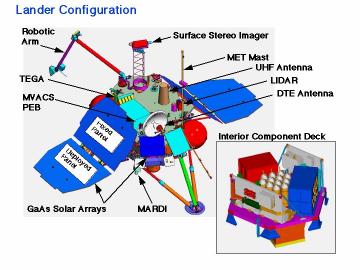
| Light Detection and Ranging (LIDAR) |
|---|
| Upward viewing lidar mounted on the Lander deck. |
| Provided by Space Research Institute (IKI) (Russian Academy of Science) under sponsorship of the Russian Space Agency (RSA). |
| LIDAR transmitter uses a pulsed GaAlAs laser diode |
2 sounding modes:
|

The LIDAR is provided by the Space Research Institute (IKI)
of the Russian Academy of Science, under the sponsorship of
the Russian Space Agency (RSA). The Principal Investigator is
Viacheslav Linkin.
The LIDAR transmitter uses a pulsed GaAlAs laser diode which emits 400 nJ energy in 100 nsec pulses at a rate of 2.5 kHz and at 0.88 µm wavelength. The LIDAR has two sounding modes. During active sounding, light pulses are emitted and their return timed in order to locate and characterize ice and dust hazes in the lowest few kilometers (< 2-3 km). An acoustic device (microphone) will also be included as part of the LIDAR assembly.
| Home | Mars Polar Lander | Deep Space 2 Microprobes | Mars Climate Orbiter |
| Welcome | Mailing List | Links | Credits |
For questions or comments on this website please refer to our list of contacts.